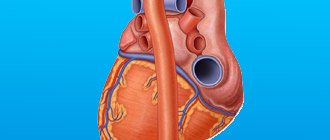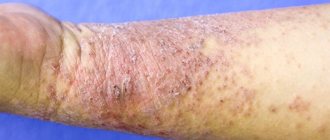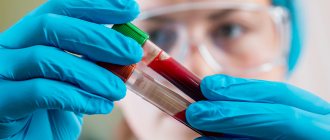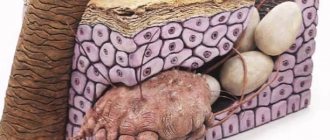Causes of heart attack
The main causes of myocardial infarction are atherosclerosis of the heart vessels, increased blood viscosity with the formation of a blood clot, and spasm of the coronary arteries. The following factors provoke and aggravate the development of these causes:
- hormonal disorders and disruptions - menopause, diabetes;
- long-term use of certain medications - hormonal drugs (oral contraceptives, corticosteroids), fat-soluble vitamins, hemostatic agents;
- hypertension;
- smoking - a bad habit causes vasoconstriction and oxygen starvation of tissues;
- obesity and lipid metabolism disorders in general - a change in the blood lipid profile towards an increase in low-density lipoproteins (LDL) leads to the formation of atherosclerotic plaques and atherosclerosis of blood vessels, including coronary ones;
- sedentary lifestyle;
- alcohol abuse provokes weakening of the heart muscle;
- frequent stress and psychological tension against the background of increased emotional sensitivity and coronary artery disease.
Consequences of myocardial infarction
Returning to your normal life after treatment will not be easy; recovery may take several months. Much depends on the form of the disease. The consequences of a large myocardial infarction can be very sad if you do not follow the doctor’s recommendations. The disease negatively affects the functioning of the entire body, so the disease will be followed by the need to completely change your lifestyle, dosing any stress on the heart - physical and emotional. After all, the consequences of a repeat myocardial infarction can be tragic.
- Patients are prescribed a number of medications for life.
- Dosed physical activity is required to tone the cardiovascular system.
- You will have to completely give up alcohol and tobacco and switch to a healthy diet.
- Attending physiotherapeutic procedures will allow you to quickly overcome negative consequences.
- It is necessary to regularly visit a cardiologist and undergo examinations to exclude a recurrent heart attack.
Unfortunately, disability after acute myocardial infarction is a common occurrence. However, how effectively you will overcome the consequences of the disease depends only on you and the qualifications of the attending physician.
Myocardial infarction: symptoms and signs
The development of symptoms depends on the form of the heart attack, its extent and type of manifestations.
The most important thing for the patient is the ability to recognize the symptoms of a pre-infarction condition. This will help you react in a timely manner and take life-saving measures.
The first signs of a heart attack:
- severe angina pectoris;
- dyspnea;
- labored breathing;
- pain in the abdomen;
- headache;
- discomfort in the chest area - a feeling of compression, pressure;
- discomfort in the upper body;
- feeling of anxiety and severe restlessness, insomnia.
The pre-infarction stage is observed in 50% of cases. It can last from 2-3 days to several weeks.
Following this, the actual acute myocardial infarction begins, which consists of several stages.
The most acute stage is manifested by severe sharp chest pain, which radiates to the neck, arms, and under the shoulder blades. The nature of the pain can be burning, bursting. The general pre-infarction symptoms include increased sweating (sticky, cold sweat), panic attacks, nausea, vomiting, pallor of the integument and mucous membranes, sudden surges in pressure, dizziness with loss of consciousness.
The acute stage is the most dangerous and decisive period in the development of a heart attack, lasting several days. During this period, the following may occur:
- rupture of the heart muscle;
- blockage of a coronary vessel by a thrombus;
- cerebral circulatory disorders.
Body temperature rises, the level of leukocytes increases sharply.
Subacute stage – the beginning of the pathological process subside, can take up to 1 month. At this time, it is necessary to reduce the temperature and level of leukocytes to normal values, restore blood circulation, start tissue regeneration processes and prevent the development of post-infarction syndrome.
The post-infarction stage is the final stage of pathology development with a period of active formation of scar tissue at the site of injury. It is at this stage that possible complications should be expected. If everything goes well, the patient’s condition quickly returns to normal.
Attention!
Without proper care and reparative therapy, 35% of patients may experience a recurrent heart attack within 3 years.
The first signs of myocardial infarction: when to take action?
Myocardial infarction is an acute condition that occurs due to coronary heart disease and is accompanied by severe circulatory failure in the coronary vessels and necrosis of part of the heart muscle tissue. In 10–12% of cases it is life-threatening for the patient. More often, heart attacks occur in men over 60 years of age, but after menopause, women are also at risk. In recent years, there has been a significant “rejuvenation” of this condition and the development of anesthesia of the heart muscle in 20-30 year old young people is observed more and more often.
In 90% of patients with coronary artery disease, a heart attack is provoked by coronary artery thrombosis caused by atherosclerosis. The following reasons can also provoke coronary circulatory insufficiency:
- thrombosis and spasm of coronary vessels;
- heart injuries;
- tumors or metastases.
- The risk group for developing a heart attack includes people with the following pathologies and conditions:
- atherosclerosis;
- hypertonic disease;
- obesity;
- diabetes;
- increased levels of LDL in the blood;
- adynamia;
- bleeding disorders;
- smoking and alcoholism;
- excessive psycho-emotional and physical stress.
Usually the attack begins suddenly, but in some patients there may be a pre-infarction condition, manifested by an increase in temperature, tachycardia and arrhythmia, cyanosis of the mucous membranes, severe pallor, an increase in blood pressure with its subsequent decrease. This condition can last from several hours to several days or weeks.
The main sign of a heart attack is severe pain in the chest, which is prolonged. It differs from the pain that occurs with angina pectoris in that it manifests itself for more than 15 minutes and is not eliminated even by repeated administration of Nitroglycerin. Usually pain occurs after physical or psycho-emotional stress.
Immediate first aid actions for a heart attack should be performed immediately after the following symptoms occur:
- severe and prolonged pain behind the sternum of a burning, stabbing, tearing, squeezing nature (it is present for half an hour and is not eliminated or is only partially relieved by the usual intake of Nitroglycerin);
- severe anxiety and fear of death;
- pain radiates to the left (sometimes to the right) arm, shoulder blade, interscapular area, neck, teeth;
- cold clammy sweat;
- dizziness or fainting;
- pallor;
- nausea;
- difficulty breathing and shortness of breath (sometimes);
- rapid and arrhythmic pulse.
In approximately 20% of cases, myocardial infarction occurs in an atypical form and is not accompanied by pain in the heart area. In such cases, symptoms may be as follows:
- with an atypical location of pain - it is concentrated in the left hand, at the tip of the little finger of the left hand, in the cervicothoracic spine or in the scapula, in the area of the lower jaw or neck, the pain syndrome is complemented by typical manifestations of a heart attack;
- with the gastric type of attack - indigestion and abdominal pain;
- with asthmatic – shortness of breath and suffocation, dry cough;
- with arrhythmic – rapid and arrhythmic pulse;
- with cerebral – confusion, dizziness, nausea and vomiting, speech disorders;
- with edema – severe weakness, shortness of breath, rapid increase in edema;
- if painless - discomfort in the chest, weakness, increased sweating.
The first signs of a heart attack and any suspicion of its development are a reason to call an ambulance. The operator must be informed about the symptoms and the possibility of a heart attack. After this, you should immediately begin providing pre-hospital emergency care.
Forms and types of myocardial lesions
Depending on the extent of damage, there are:
- small focal infarction - affects a small area of the myocardium and rarely leads to serious consequences;
- large-focal infarction - the symptoms are more serious, damage to a large area of the heart muscle requires long-term treatment, often leads to complications and can recur within 6-12 weeks, and death is possible.
Taking into account the characteristics of the symptoms, they distinguish:
- anginal form - with severe angina and pain in the throat;
- asthmatic form - with severe shortness of breath and chest pain, which quickly turns into suffocation and cardiac asthma. Accompanied by pulmonary edema, blue lips, severe cough and wheezing;
- gastralgic form - manifests itself as nonspecific stabbing pain throughout the abdomen and resembles an attack of peptic ulcer. Characteristic intestinal reactions are observed: nausea, vomiting, belching, bloating, diarrhea. As a rule, it develops with severe physical and mental exhaustion;
- cerebral form - with the absence of pain in the heart area and a general set of symptoms of a pre-stroke state: headaches, dizziness, nausea, vomiting. numbness or paralysis of the hands, slow speech;
- arrhythmic form - with severe arrhythmia and decreased blood pressure; accompanied by cardiogenic shock, which causes a decrease in myocardial contractility with a high risk of death. The situation is aggravated by the difficulty of identifying this form using an ECG;
- edematous form – there is extensive swelling of the body tissues with an enlarged liver. Often develops in people with heart failure;
- painless form - when painful sensations in the body are completely absent or greatly smoothed out;
- low-symptomatic form - can only manifest itself as severe fatigue and drowsiness. It is considered the most dangerous type of heart attack, as it is diagnosed too late for a successful treatment outcome.
Forms of myocardial infarction
The classification of the disease is quite extensive and depends on the location and nature of development.
The affected area of the heart may be:
- in the left ventricle (anterior, posterior, lateral, and inferior myocardial infarction are distinguished);
- at the apex of the heart muscle;
- in the interventricular septum;
- in the right ventricle (the least common form).
Various combinations are also known: posteroanterior, inferolateral infarction.
Depending on the width of the affected area, small-focal and large-focal (extensive) myocardial infarction are distinguished. The latter form covers most of the myocardium and is caused by thrombosis of a large vessel or arterial spasm. Small focal infarctions account for about 20% of the total number. During development, there may be no vascular ruptures or other manifestations.
Depending on the damage to one or another cardiac layer, there are subendocardial, subepicardial, intramural, and acute transmural myocardial infarction.
Depending on the nature of the course, monocyclic, protracted, recurrent, and repeated myocardial infarction occurs.
There are a number of atypical forms of the disease:
- abdominal – symptoms similar to acute pancreatitis;
- asthmatic – similar to an asthma attack with shortness of breath;
- cerebral – accompanied by dizziness, disturbances of consciousness;
- asymptomatic – typical for people with reduced sensitivity (for example, with diabetes).
Specific forms of pathology are also known, in particular myocardial infarction q, the name of which was given by a certain wave on the ECG, which is recorded only in this form. The level of enzymes increases in the cardiac tissues, and extensive ischemic changes occur (death of a muscle area).
The most severe form is considered to be acute transmural myocardial infarction - all layers of the heart are affected. This disease is always extensive and large-focal, and among the consequences, post-infarction cardiosclerosis is often recorded - scarring of large areas of tissue.
Only an experienced and qualified doctor can accurately determine the form, degree of complexity and stage of the pathology. He will take emergency measures so that you can avoid trouble.
Complications
If the obstruction of the coronary artery is not corrected in time, the area of muscle tissue dies and is replaced by scar tissue. This provokes the development of a number of cardiac pathologies:
- arrhythmia – if during myocardial infarction there is damage to a section of the conduction system of the heart, a “short circuit” occurs with cardiac arrhythmia of varying degrees of severity;
- heart failure - with extensive damage, there is a lack of muscle tissue for full contraction of the heart and blood circulation; shortness of breath, fatigue, swelling occur;
- pathologies of valve function - with damage to nearby areas of the myocardium;
- cardiac arrest - when muscle tissue is weakened, especially with a repeated heart attack, myocardial ruptures are possible with immediate death.
Post-infarction syndrome, or Dressler's syndrome, is a complication with an autoimmune mechanism of development. Occurs in the 2nd week from the onset of the attack with a frequency of 3-4%. The body begins to perceive the cells of the heart muscle as foreign and attacks them, causing autoimmune pleurisy, pericarditis, pneumonitis, synovitis with a pronounced increase in body temperature up to 39 C and general weakness of the body. The risk of pathology is especially high with extensive and repeated heart attacks.
Mechanism of development of acute coronary syndrome
Myocardial infarction, which, along with an episode of unstable angina, is included in the concept of acute coronary syndrome, is an exacerbation of coronary heart disease. During myocardial infarction, necrosis of the heart muscle develops due to acute disruption of the blood supply. In most cases, this occurs as a result of atherothrombosis, in which the coronary vessels are partially or completely blocked by a blood clot. The disease is manifested by sudden intense pain in the chest, tachycardia, “cold sweat”, pallor of the skin and a number of other symptoms.
The goal of treating an acute heart attack is to quickly restore blood supply. However, even after blood flow is established, therapy cannot be stopped, since coronary atherosclerosis, which became the foundation for the development of acute coronary syndrome, is chronic.
Diagnosis of heart attack
A timely and competent diagnosis can save the patient’s life. With immediate treatment, there is a chance to restore the functional activity of the heart even with extensive damage.
Attention!
During a medical interview, it is very important to describe any subjective sensations, even the most insignificant ones. It is also necessary to provide comprehensive information about your health in general.
The main diagnostic methods are instrumental examination and laboratory tests.
Carry out:
- ECG - a graph with the performance characteristics of cardiac structures helps to identify the main area of the infarction; determines the frequency and rhythm of the heartbeat, the presence of thromboembolism, changes in the heart muscle, etc.;
- echocardiography (ultrasound) – reveals failure of contractility of the heart muscle and localization of the pathological focus;
- myocardial scintigraphy (radioisotope study) - the principle of operation of the method is that a radioisotope substance accumulates in the damaged area;
- coronary angiography – determines the condition of the heart vessels and the presence of blood clots;
- positron emission tomography – to identify areas of muscle tissue with circulatory disorders;
- MRI, CT - to form a general picture of the structures of the heart - size, condition of the chambers, presence of hypertrophies, blood clots.
Laboratory tests include general and biochemical blood tests, as well as tests to determine cardiac-specific markers - enzymes that are released into the blood when the heart muscle tissue is damaged.
Cardiac specific tests:
- troponin test is the most sensitive in an acute process, the standard for rapid detection of necrotic changes in the heart muscle. The higher the concentration, the larger the focus of necrotic changes. Enzyme levels begin to rise 3-4 hours after the attack and reach peak values after 48 hours;
- myoglobin test - myoglobin begins to increase after 2-3 hours and reaches a maximum after 10 hours, its concentration depends on gender - in men it will be higher with an equal volume of lesions;
- lactate dehydrogenase test - determines the level of LDH-1, which is released into the blood 8 hours after an attack and reaches its highest values after 3 days;
- creatine phosphokinase test – detects the MB fraction of creatine phosphokinase; its values increase after 4-8 hours, reaching a maximum after 24 hours, but quickly fall;
- aspartate aminotransferase (AST) test is the least specific test, since AST is found in large quantities in other organs and tissues; used as an additional indicator of acute condition. at which its level can increase by 5-20 times the norm.
General and biochemical blood tests reveal:
- increase in leukocyte levels;
- increased ESR;
- “inflammatory” proteins – C-protein, fibrinogen, gamma globulin, etc.
Complications of myocardial infarction
The degree of complications depends on the form of the disease. Most often, with a large heart attack, the heart loses its normal ability to contract, so the patient develops various arrhythmias. Acute heart failure, expressed in shortness of breath and lack of oxygen, is also common. Autoimmune complications are diagnosed.
Immediately after a heart attack, inflammatory processes may develop in the affected area. A small percentage of complications occur due to violations of the integrity of the heart muscle: the mitral valve may fail, and myocardial rupture may occur. Pericarditis and aneurysm occur. In some cases, the disease negatively affects other organs - in particular, it causes pulmonary edema.
Among late complications, neurotrophic disorders are the most common. Most patients are diagnosed with post-infarction syndrome. Cases of parietal thromboendocarditis are common.
Treatment
To obtain the best results, treatment for myocardial infarction should begin as soon as possible. Basic measures are carried out immediately after hospitalization, before the end of the main diagnosis:
- eliminate pain syndrome - use drug therapy using a different range of drugs - starting from nitroglycerin (sublingual, intravenous) and ending with morphine injections;
- restore blood circulation - use thrombolytics, anticoagulants, antiplatelet agents.
Further therapy, depending on the examination data, is aimed at preventing and eliminating arrhythmias, cardiogenic shock, and heart failure. Antiarrhythmic drugs, antispasmodics, sedatives, adrenergic blockers, etc. are prescribed.
Diagnosis and treatment at CBCP
The Center for Pathology of the Circulatory Organs provides patients with ample opportunities for diagnosis, treatment and rehabilitation after a heart attack.
Have you noticed the first signs of heart problems? Don't wait for them to develop into a serious disease with a negative prognosis. Get diagnostics at CBCP using modern European-level equipment. Our specialists will identify the slightest changes in the cardiovascular system and prescribe treatment that will prevent you from developing myocardial infarction to the maximum extent.
Do you need professional rehabilitation after an illness? We offer effective techniques based on innovations in cardiology.
First aid for heart attack
If you detect symptoms of a pre-infarction condition or a completed heart attack, the first thing to do is call an ambulance:
- 103 – medical service telephone number;
- 112 is a single emergency number.
These numbers work for both mobile and landline phones.
Before the cardiac team arrives:
- remove the victim from any physical activity;
- put him in bed, slightly raising the head of the bed;
- loosen tight clothing - unbutton the collar of your blouse/shirt, belt, remove narrow shoes;
- try to calm the person down - talk to him, give him water to drink;
- if there is no negative reaction to aspirin, give 1-2 tablets to slow down the growth of the blood clot;
- provide fresh air access to the room - open windows and doors;
- monitor blood pressure and pulse while waiting for the ambulance to arrive;
- If you lose consciousness, perform cardiopulmonary resuscitation.
Important!
For high blood pressure, if the victim is taking nitroglycerin, place a tablet under the tongue. If the patient has not encountered this drug, as well as with low blood pressure values, the use of nitroglycerin can greatly “drop” the pressure.
Prevention
Considering the severity of the consequences of a heart attack, it is much more promising to direct your efforts to prevent it. The list of basic preventive measures includes:
- correction of diet - exclude fatty, fried, smoked, salty and sweet foods; give preference to vegetable oils with a high HDL content (flaxseed, mustard, cedar), fresh fish and seafood, fresh vegetables, fruits, berries, nuts and seeds, whole grain cereals, meat, poultry and dairy products with a low fat content;
- maintaining a physical activity regime - do cardio training, fitness, swimming; practice evening walks or jogging, try to be in the fresh air more often - this not only helps burn fat, but also strengthens the heart muscle and keeps blood vessels in good shape;
- give up bad habits;
- try to avoid prolonged stress and psychological overload;
Periodically monitor your lipid profile, sugar levels, and blood pressure values.
On a note!
Diabetes is closely related to atherosclerosis - where there is one pathology, the shadow of another is invisibly present. Therefore, for those who are at risk, attention to blood counts should be tripled.
And, of course, do not forget about preventive examinations by a specialist.









